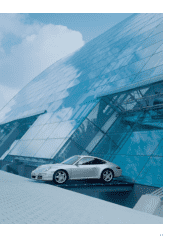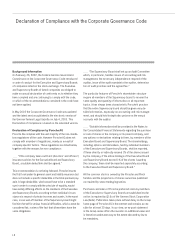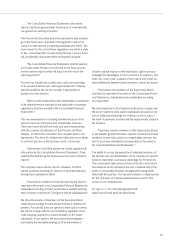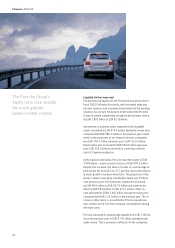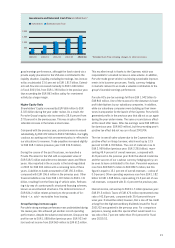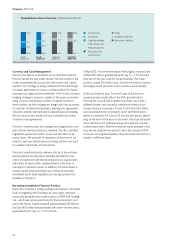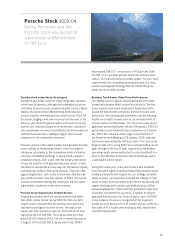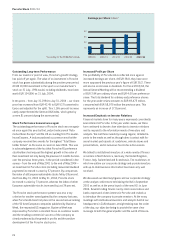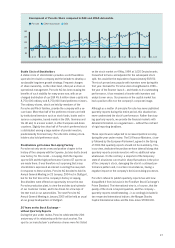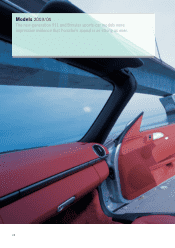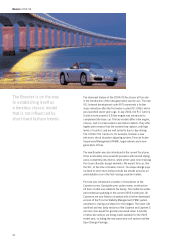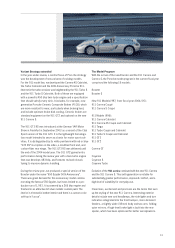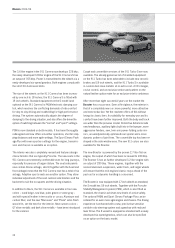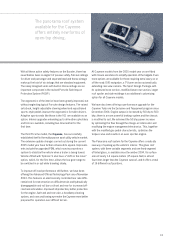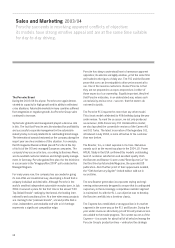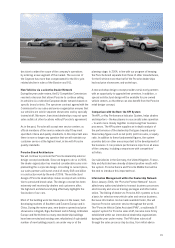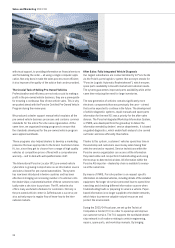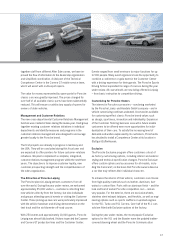Porsche 2003 Annual Report Download - page 31
Download and view the complete annual report
Please find page 31 of the 2003 Porsche annual report below. You can navigate through the pages in the report by either clicking on the pages listed below, or by using the keyword search tool below to find specific information within the annual report.
27
Stable Circle of Stockholders
A stable circle of stockholders provides a solid foundation
upon which to build a company and the latitude to develop a
sustainable long-term growth strategy. Frequent changes
of share ownership, on the other hand, often put a strain on
operational management. Porsche AG has been reaping the
benefits of such stability for many years now, with an un-
changed distribution of our EUR 45.5 million share capital into
8,750,000 ordinary and 8,750,000 listed preference shares.
The ordinary shares, which are held by members of the
Porsche and Piëch families, provide the company with a se-
cure base. More than half of the preference shares are held
by institutional investors such as stock funds, banks and in-
surance companies, based mainly in the USA, Germany and
the UK and, to a lesser extent, in other European and Asian
countries. Slightly less than half of Porsche’s preferred stock
is distributed among a large number of private investors,
predominantly from Germany. Porsche AG’s ordinary stock-
holders also hold preference stock.
Stockholders get to know the Leipzig Factory
Porsche not only wrote a new and positive chapter in the
history of the company with the Cayenne, but also built a brand
new factory for this model – in Leipzig. Both the Cayenne
sports SUV and the high performance Carrera GT sports car
are made there. It was therefore not surprising that many
stockholders expressed an interest in visiting the new plant.
In response to these wishes, Porsche AG decided to hold its
Annual General Meeting on 23 January, 2004 not in Stuttgart,
but for the first time in the company’s history in Leipzig.
Stockholders were offered an opportunity to tour the new
Porsche production plant, to view the architectural splendor
of our Customer Center, and to be driven for a few laps of
the test track in our automobiles. The next Porsche AG
Annual General Meeting in January 2005 will be held as usual
at our group headquarters in Stuttgart.
20 Years on the Stock Exchange –
without Quarterly Reports
During the year under review, Porsche celebrated the 20th
anniversary of its relationship with the stock market. The
sports car manufacturer’s preference shares were first listed
on the stock market on 4 May, 1984 at 1,020 Deutschmarks.
Converted to Euros and adjusted for the subsequent stock
split, this would be the equivalent of approximately EUR 50.
The stock proved very popular with investors even during this
first year. Demand for Porsche stock strengthened in 1996 –
the year of the Boxster launch – and thanks to its outstanding
performance, it has remained a favorite with investors and
analysts ever since. Our presence in the capital market has
had a positive affect on the company’s corporate image.
Although as a matter of principle Porsche has never published
quarterly reports during this entire period, this situation has
never undermined the stock’s performance. Rather than issu-
ing quarterly reports, we provide the financial markets with
detailed information on a regular basis – without the restraint
of rigid reporting deadlines.
These reports were subjected to increased political scrutiny
during the year under review. The EU Finance Ministers, close-
ly followed by the European Parliament, agreed in the Spring
of 2004 that quarterly reports should not be mandatory. This,
in our view, vindicates the position we have taken all along: that
quarterly reports provide investors with no additional value
whatsoever. On the contrary: a snapshot of the temporary
state of a business can result in sharp fluctuations in the price
of the company’s stock, damaging the stock’s continued per-
formance pattern and, in certain circumstances, having a
negative impact on the company’s decision-making processes.
Porsche’s refusal to publish quarterly reports has until now
disqualified it from inclusion in the Frankfurt Stock Exchange’s
Prime Standard. The international view is, of course, that the
quality of the stock is beyond question, and the company –
quarterly reports notwithstanding – is accordingly included in
two respected international indices: the Morgan Stanley
Capital International index and the Dow Jones STOXX 600.
Development of Porsche Share compared to DAX und CDAX-Automobile
Porsche CDAX- Automobile DAX
160
140
120
100
80
1.8.03 1.9.03 1.10.03 1.11.03 1.12.03 1.1.04 1.2.04 1.3.04 1.4.04 1.5.04 1.6.04 1.7.04 31.7.04


